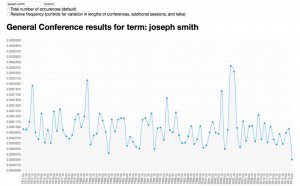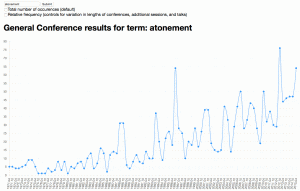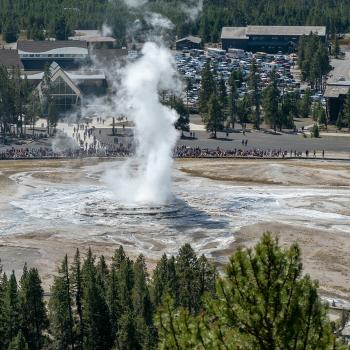
(Click to enlarge)
I posted an entry the other day entitled “Ashamed of Joseph?” in which I noted that some critics had detected, and were celebrating, a sharp decline in mentions of the Prophet Joseph Smith during the just-concluded General Conference of the Church of Jesus Christ of Latter-day Saints.
They claim that leaders and members of the Church are backing away from Joseph, repulsed and embarrassed by his poor character and manifest fraudulence — or some such thing.
I don’t believe it, and I emphatically don’t grant the assumption that he was a fraud with poor character. Quite the contrary.
Still, was there a sharp reduction in allusions to Joseph Smith during the most recent Conference?
Possibly. I haven’t independently counted or verified the numbers.
But I’m not sure, even if it were true, that it would mean much. Perhaps, if there’s eventually seen to be a continuing trend, we’ll recognize this as the beginning of an evolution of the Utah church that will turn it into the Great Basin subdivision of the Community of Christ. But I’m not holding my breath before seeing that, and I would advise our critics and detractors, for their own good, not to do so, either.
What we had over Easter weekend — and, as I’ve observed previously, the fact that Conference occurred on Easter weekend probably isn’t wholly irrelevant to the seeming paucity of references to Joseph Smith — was probably an outlier. After all, a single talk focused on Joseph might have made an enormous difference, because it would likely include numerous mentions of him. Likewise a single talk less that’s devoted to a topic closely connected with Joseph would have a large impact, too. Such numbers, based on a fairly small sample — since only a tiny handful of talks in any Conference are ever devoted to the Prophet or anything directly connected with him, requiring mention of his name –and extrapolated from that small sample, will tend to be quite volatile.
In this connection, though, Doug Ealy has kindly shared a couple of graphs with me of his own devising, based on data gathered from April 1971 through April 2015, that I think you might find of interest. (You’ll need to click on the images to enlarge them to readable size.) The first concerns the issue of frequency of allusions to Joseph Smith:

(Click to enlarge.)
You can easily see the volatility to which I referred, but no clear trend is apparent. (The biggest spike upwards comes in October of 2005, shortly before the bicentennial of the Prophet’s birth.) Critics hope that the most recent Conference represents the beginning of a long-term abandonment of Joseph, but, thus far, their hope is merely that. No evidence supports their explanation that it comes from a sudden urge on the part of Church leaders to distance themselves from the founder of the Restoration.
More interesting, to me, is the second graph, which, although it too indicates volatility, does seem to suggest a longterm trend toward more and more frequent references to the Atonement of Jesus Christ. I think this is likely to be true, and I think it reflects, among other things, President Ezra Taft Benson’s call for the Saints to rediscover the Book of Mormon, which features the Atonement of Christ as one of its principal themes.

(Click to enlarge. Click again to enlarge still further.)
Of course, the search for the numbers underlying this graph was done, as I understand it, on the specific term atonement, so the trend may, in whole or in part, simply reflect a change in linguistic habit or terminological fashion. More work would need to be done in order to rule that out.











